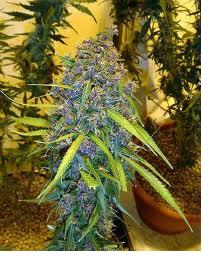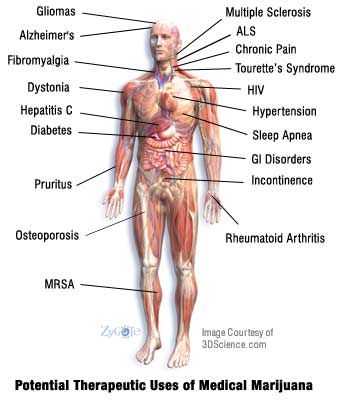|
Di seguito tutti gli interventi pubblicati sul sito, in ordine cronologico.
This frightening belief was popularized in the 1970s when Ronald Reagan famously stated, “the most reliable scientific sources say permanent brain damage is one of the inevitable results of the use of marijuana.”

In the following years, Reagan’s scientific sources would be discredited and subsequent studies would be unable to replicate any evidence of brain damage, yet the myth remains as prominent today as it was 40 years ago.
False Monkey Study
Dr. Robert G. Heath was a researcher at Tulane University in New Orleans when he reported the findings of an experiment that apparently proved a connection between marijuana use and brain damage. Dr. Heath had conducted the study on rhesus monkeys by exposing them to an equivalent of 30 marijuana joints per day. After 90 days, the monkeys began to waste and die. When they were later autopsied, Dr. Heath reported significant brain damage in the monkeys that had been exposed to cannabis.
Despite strong support from the federal government, the study was heavily criticized for inaccurate procedures upon its release. Critics suggested that suffocation may have been the actual cause of brain damage instead of marijuana itself.
The findings were challenged and ultimately dismissed by a pair of larger, better-controlled studies – one by Dr. William Slikker of the National Center for Toxicological Research and the other by Charles Rebert and Gordon Pryor of SRI International – that attempted to replicate Dr. Heath’s results without success. The studies showed no change in the brain structure of monkeys that were given daily doses of marijuana for up to one year.
Human Studies
A number of studies have been conducted on human marijuana users over the past few decades, beginning in the 1970s as well.
In 1971, a study published by Campbell et al. involving 10 heavy users seemed to demonstrate a decrease in brain cells in a specific area of the brain, adding further to public concerns over marijuana use and brain damage. However, subsequent studies (Co et al., 1977, Hannerz and Hindmarsh, 1983 and Kuehnle et al., 1977) failed to replicate these findings, suggesting that the initial study was flawed yet again.
Recent research conducted on human subjects has also revealed conflicting evidence on marijuana use and brain damage. A study published in 2000 by researchers at the University of Iowa found no evidence of cerebral atrophy or regional volume differences in MRI scans of frequent cannabis users when compared to non-users.
On the other hand, the support for marijuana use causing brain damage seems to be stronger in studies that separate users by age. An early study conducted by Wilson et al. (2000) found that marijuana users who started using before the age of 17 seemed to exhibit noticeable changes in brain matter volume. However, the study found no differences in whole brain volumes overall.
In 2012, Duke University researchers published the results of a study that seemed to show that adolescents who started using marijuana before the age of 18 – and diagnosed as addicted by the time they were 38 – experienced a drop in IQ by early adulthood. The study suggested that heavy users could lose as much as 8 IQ points. However, an analysis published a few months later in the same medical journal determined that the findings of the previous study were once again plagued with inaccuracies and – using a statistical model to evaluate the original study’s data – seemed to show that there was no correlation between marijuana use and a drop in IQ.
Finally, studies that have investigated the effects of marijuana on brain cells have revealed findings that directly contrast with the popular belief of marijuana causing brain damage. In fact, a study published in 2005 showed that a synthetic form of THC could increase the growth of new brain cells – a process known as neurogenesis. CBD has also been found to have a similar effect on brain cell generation. Taken together, these findings seem to contradict the notion that marijuana may cause abnormal brain development in adolescent users.
Warning: Alcohol and Caffeine Can!
Most commonly abused substances – including alcohol and caffeine – can cause permanent brain damage so it may be a surprise to hear that marijuana is safe in this regard. Although users of marijuana may not be at risk of neurological damage, cannabis is still a psychoactive substance that subjects its user to a temporarily altered state of mind.
Source: truthonpot.com
Nevertheless, the argument of its addictive potential remains.
In the US, marijuana is classified as a Schedule I substance, meaning that it must fulfill the requirement of having “a high potential for abuse”. But what exactly does this mean?

What is Drug Abuse?
Drug (or substance) abuse is defined as a pattern of drug use that occurs in amounts or by methods that are neither approved nor supervised by medical professionals.
Based on this definition, it is easy to see why marijuana may be considered as having a high potential for abuse, simply due to the fact that most medical professionals are unwilling to recommend or support its use. However, reasons for this lack of support are still unclear.
Since studies continue to show that marijuana poses little to no risk of long-term side effects, many are led to believe that marijuana must be dangerously addictive. But once again, scientific evidence suggests the contrary.
Addiction Potential
Studies estimate that only 1 in 10 individuals who try marijuana will ever become a regular user and display signs of dependence or addiction. Furthermore, health experts such as Dr. Jack E. Henningfield of the NIDA have ranked marijuana as the least addictive drug among substances such as caffeine, nicotine and alcohol.
Even still, marijuana addiction (also known as cannabis dependence) is a real medical condition that will affect a significant portion of users at some point in their lives.
What is Cannabis Dependence?
Cannabis dependence is a clinical condition that is classified according to DSM-IV guidelines. The DSM-IV is used by doctors in the United States and provides a standard criteria for the classification of mental conditions.
According to the DSM-IV, cannabis dependence is defined as:
A pattern of cannabis use that leads to 3 (or more) of the following symptoms:
1. Tolerance
2. Withdrawal
3. The substance is often taken in larger amounts or over a longer period than was intended
4. There is a persistent desire or unsuccessful efforts to cut down or control substance use
5. Large amounts of time are devoted to obtaining and using the substance and recovering from its effects
6. Important social, occupational or recreational activities are given up or reduced because of substance use
7. Continued use despite knowledge of having a persistent or recurrent physical or psychological problem that is likely to have been caused or exacerbated by the substance
Criteria adapted from the Diagnostic and Statistical Manual of Mental Disorders, Fourth Edition, Text Revision. Washington, DC, American Psychiatric Association, 2000 (DSM-IV-TR)
Tolerance and Withdrawal Symptoms
Some argue that marijuana differs from other substances in the sense that it is only ‘psychologically’ addictive – but this is not true.
While the psychological symptoms of addiction may be more prominent in cannabis users, studies show that cannabis dependence is accompanied by physical symptoms – such as tolerance and withdrawal – as well.
Tolerance occurs when increasing amounts of marijuana are necessary to achieve the desired effects. Tolerance is common among daily users and can be explained by the amount of time the body takes to metabolize cannabinoids such as THC.
Evidence suggests that THC can remain in the body for a significant amount of time, even after its effects have worn off. Furthermore, THC levels can build up in regular users and have been detected in blood samples taken after a month of no intake. When traces of THC are stored in the body over time, larger quantities of marijuana are necessary for users to achieve their desired ‘high’.
Withdrawal is another physical symptom of addiction that occurs when marijuana use is stopped after a period of regular use. Studies show that marijuana users are prone to a specific set of withdrawal symptoms, which include anxiety, irritability, physical tension, and decreases in mood. Once again, withdrawal is due to the build up of cannabinoid levels that occurs during regular use.
Research has found that withdrawal symptoms are most noticeable during the first 10 days of abstinence, but may be present for up to 28 days in some users. Overall, the symptoms and severity of withdrawal are expected to vary from user to user.
Source: truthonpot.com
Numerous studies have come to this conclusion after investigating the toxicity of marijuana and its active components – chemicals known as cannabinoids.

Studies have mostly focused on the toxicity profile of the cannabinoid tetrahydrocannabinol (THC) because of its potent psychological effects. What they’ve found is that although THC is a psychoactive substance and is responsible for the “high” that marijuana users experience, it is also remarkably non-toxic.
What The Studies Say
Many studies have set out to investigate the toxicity of cannabis and its various constituents. These studies measure toxicity levels by determining the median lethal dosage (LD-50). The LD-50 measurement is the point at which 50% of the test animals die (a 50% lethal dosage).
Studies involving small animals such as rats have established an LD-50 point for THC at incredibly high levels (around 1000mg/kg). Studies involving larger animals such as monkeys and dogs have failed to achieve an LD-50 point, even at enormous doses of over 3000mg/kg.
Although an LD-50 rating has never been established in humans, estimates can be made by extrapolating the results of animal studies.
The non-fatal dosage of 3000mg/kg given in studies of larger animals would be equivalent to an average 70 kg human ingesting 210 grams of pure THC. Given that the average level of THC found in marijuana is approximately 10%, a person would have to smoke 2.1 kg of marijuana all at once in order to reach the same levels of THC as seen in toxicity studies.
With these numbers in mind, its easy to see why marijuana is far less toxic than everyday substances such as aspirin (LD-50: 200mg/kg) and caffeine (LD-50: 192 mg/kg). In 2008, The Canadian Medical Association Journal published a review study spanning 30 years of research, concluding that there are no serious adverse effects of using marijuana.
‘Greening out’
Although ingesting too much marijuana cannot cause death or permanent disability, a temporary form of overdose is common, especially in new or inexperienced users of the drug. This phenomenon is casually referred to as ‘greening out’ and usually results in some combination of the following symptoms:
- Feelings of anxiety, paranoia or fear
- Nausea and vomiting
- Increased heart rate
- Uncontrollable shaking
- Hallucination and/or disorientation
Thankfully, ‘greening out’ is only a temporary phenomenon and will naturally pass within a few hours.
In extreme cases, it may be wise to seek medical assistance for someone suffering from a marijuana overdose in order to ensure their safety if anything were to go wrong. There is always the possibility that marijuana obtained from the underground market may be laced (or “cut”) with other drugs, in which case the danger of the situation becomes severely amplified.
Source: truthonpot.com
The measure is backed by the government of President Jose Mujica, who says it will remove profits from drug dealers and divert users from harder drugs.

Under the bill, only the government would be allowed to sell marijuana.
The state would assume "the control and regulation of the importation, exportation, plantation, cultivation, the harvest, the production, the acquisition, the storage, the commercialisation and the distribution of cannabis and its by-products".
Buyers would have to be registered on a database and be over the age of 18. They would be able to buy up to 40g (1.4oz) per month in specially licensed pharmacies or grow up to six plants at home.
Foreigners would be excluded from the measure.

Political tussle
The bill was approved by 50 of the 96 MPs present in the lower house following a fierce 13-hour debate in the capital, Montevideo.
The supporters of the measure argued that the fight against drugs and drug trafficking had failed, and the country needed "new alternatives".
"The regulation is not to promote consumption; consumption already exists," said Sebastian Sabini of the governing centre-left Frente Amplio (Broad Front) coalition, which has a majority of one in the lower house.
Marijuana use has reportedly doubled in Uruguay over the past year. An estimated 22 tonnes of marijuana are being sold in the country annually, according to Uruguay's National Drugs Committee.
But Gerardo Amarilla of the opposition National Party said the government was "playing with fire" given the health risks he said were linked to marijuana use.
All eyes were on Dario Perez, a member of the governing coalition but a strong opponent of the bill, whose vote could have scuppered the bill.
During his 20-minute speech, Mr Perez reiterated his belief that the issue should be put to a referendum and not have been "imposed" by the government.
But to applause by supporters of the bill in the public gallery, he finally concluded that as long as he was a member of the coalition, he would vote with it, despite his personal misgivings.
The bill is now expected to be approved by the Senate, where the left-wing government has a bigger majority.
But opposition politicians said that even if the law made it through the senate, they would launch a petition to have it overturned.
A survey carried out before the vote by polling organisation Cifra suggested 63% of Uruguayans opposed the bill.
Papal opposition
The progress of the bill is being watched closely across the region, says BBC Mundo correspondent in the region Ignacio de los Reyes.
For decades, drug trafficking has caused tens of thousands of deaths throughout Latin America.
Uruguay may have not experienced the bloodshed caused by drug trafficking, but the proposal could be seen as a test for violence-torn nations looking for an end to their drug wars, our correspondent adds.
The vote also comes just days after Pope Francis criticised drug legalisation plans during a visit to neighbouring Brazil.
The pontiff said it was "necessary to tackle the problems which are at the root of drug abuse, promoting more justice, educating the youth with the values that live in society, standing by those who face hardship and giving them hope for the future".
Source: bbc.co.uk
First isolated by scientists in 1964, THC was later discovered to act within the natural cannabinoid system of the human body – the endocannabinoid system – in order to elicit its effects.

THC has a wide variety of effects on its user, affecting both the mind and body. Not only is THC responsible for many of the medicinal effects of marijuana, but it is also the chemical that causes users to feel “high” after ingesting marijuana.
Natural Occurrence
THC is produced naturally by the flowers of the female Cannabis plant and is just one of over 60 cannabinoids that are produced. The levels of THC contained in each plant vary according to strain. While some strains of marijuana like hemp have almost no THC at all, others have been selectively bred in order to achieve THC levels as high as 25%.
Cannabidiol (CBD) is another commonly known cannabinoid that is found in marijuana. Medical marijuana strains are frequently labelled with both THC and CBD levels, as both cannabinoids elicit their own unique effects on their users.
Short-term Effects of THC
Although cannabinoid receptors are found throughout the human body, THC acts mostly on the receptors found within the brain. This is why THC has such strong psychoactive properties and is closely associated with the “high” that marijuana users experience.
Along with feelings of euphoria, THC has also been reported to induce relaxation, alteration of sights, sounds and tastes, fatigue and increased appetite.
Medical Properties of THC
Extensive research over the past few decades has found THC to possess numerous medical properties that are beneficial in a wide range of disorders, some of which include:
- Alzheimer’s Disease
- Atherosclerosis
- Glaucoma
- Multiple sclerosis
- Parkinson’s Disease
- Sleep apnea
- Tourette Syndrome
- Cancer (various forms)
- and many more…
THC also has antiemetic (anti-nausea) properties, which makes it useful for treating AIDS and chemotherapy patients.
Marinol® – a pure THC pill – is legal for medical use and is available for patients in certain countries such as Canada, United States and Germany. However, patients have reported feeling too intoxicated from Marinol®, likely because of the lack of other cannabinoids which naturally occur in the Cannabis plant and help to mitigate the psychoactive effects of THC. Newer cannabinoid-based medications are being developed to include other medicinal cannabinoids such as CBD (cannabidiol) in hopes of maximizing medical potential and reducing adverse side-effects.
Toxicity
Although the toxicity level of THC has never been tested on humans, animal studies have demonstrated it to be remarkably non-toxic. Studies involving small animals such as rats have shown that a tremendous amount of THC (around 1000mg/kg) must be administered in order for death to occur. Other studies involving larger animals failed to result in death even when doses of THC of up to 3000mg/kg were administered.
Not a single case of human death by THC overdose has ever been documented.
Long-term Effects of THC
Studies documenting the long-term effects of THC intake have had varied and inconsistent results. Although highly debated, certain studies have found long-term use to result in the following negative side-effects:
- Short-term memory loss
- Lower mental aptitude scores
- Higher rates of psychosis and schizophrenia
However, there has yet to be any conclusive evidence of any negative long-term effects associated with THC intake.
Source: truthonpot.com
CBD was first isolated by researchers in 1940 but its structure was not identified until 23 years later.

Natural Occurrence
Although scientists have identified over 60 different cannabinoids in the marijuana plant, CBD is present in abundant levels and represents up to 40% of cannabis extracts.
Like THC, the concentration of CBD is highly variable from strain to strain. CBD levels are suggested to have declined over past years due to the preference and selective breeding of marijuana with higher THC levels in the underground market.
Effects of CBD
CBD can’t get you high – it doesn’t act on CB1 receptors and therefore has no psychoactive properties. This single factor makes CBD a much more useful compound, both legally and medicinally.
In addition to being non-psychoactive, CBD has even been found to counteract a number of the psychoactive effects of THC. Studies have shown CBD to lessen the hallucinogenic effects of THC, block THC’s interference with memory and decrease social isolation induced by THC.
Strains and pharmaceuticals (such as Sativex) that balance THC with high CBD levels are able to enhance the benefits of THC while reducing its negative psychoactive effects.
Safety of CBD
Many studies have been conducted on CBD to evaluate different aspects of its safety. Some of the findings include:
Embryonic Development – Studies conducted to evaluate the safety of CBD intake for pregnant mothers found it to have no significant effect on developing embryos.
Food Intake – Studies have found that, unlike THC, CBD does not increase food intake. A study found that chronic administration of CBD for up to 2 weeks actually reduced weight gain in rats, suggesting that CBD may have the opposite effect of THC on food intake.
Motor Changes – Studies have not found CBD to induce motor changes, unlike THC.
Physiological Effects – CBD seems to have no effect across a wide range of physiological measures, including blood pressure, heart rate and body temperature.
CBD, like THC, is remarkably non-toxic and no human overdose has ever been recorded.
Medical Uses of CBD
CBD possesses an incredibly wide range of medicinal properties, similar to THC. However, CBD is not psychoactive and thus has a clear advantage over THC for use as a medicine. Studies have demonstrated CBD to exhibit the following list of therapeutic properties:
Anti-inflammatory – making it useful in treating multiple sclerosis and other neuroinflammatory disorders
Anticonvulsant – making it useful in treating epilepsy
Antiemetic (anti-nausea) – making it useful in treating chemotherapy and AIDS patients
Anti-tumoral – making it useful in fighting various forms of cancer
Antipsychotic – Making it useful in treating schizophrenia
Anxiolytic (anti-anxiety) and Anti-depressant – making it useful in treating anxiety and depression disorders
Anti-oxidant – making it useful in treating Parkinson’s Disease, Huntington’s Disease and numerous other neurodegenerative disorders
Sleep-inducing – making it useful in treating various sleep disorders
Despite its potential as a therapeutic agent in so many disorders, current research is still in the early stages and has yet to progress to clinical trials for the vast majority of listed conditions. Unfortunately, the legal status of CBD and its close association with marijuana continue to hinder its progress towards widespread access and use of CBD as a medicine.
Source: truthonpot.com
What led to this understanding was the discovery of the endocannabinoid system – a unique biological system that facilitates the activity of medical marijuana within the human body.

What Is The Endocannabinoid System?
The endocannabinoid system is a central regulatory system that affects a wide range of biological processes. It consists of a group of molecules known as cannabinoids as well as the cannabinoid receptors that they bind to.
Although marijuana is a source of over 60 cannabinoids (including THC and CBD), the human body produces a number of cannabinoids as well. These endogenous cannabinoids include anandamide and 2-arachidonoylglycerol (2-AG) and are present in all human beings.
Decades of scientific research on the endocannabinoid system has resulted in the discovery of two types of cannabinoid receptors, CB1 and CB2. These receptors are found in various parts of the body, but are most prominent in the brain and immune system.
Cannabinoid receptors act as binding sites for endogenous cannabinoids as well as cannabinoids found in marijuana. When cannabinoids bind to CB1 or CB2 receptors, they act to change the way the body functions.
While cannabinoid receptors are primarily expressed in the brain and immune system, researchers have identified cannabinoid receptors in a variety of other places as well, including the peripheral nervous system, cardiovascular system, reproductive system, and gastrointestinal and urinary tracts. Cannabinoid receptors continue to be identified in unique parts of the body as research on the endocannabinoid system progresses.
What Does It Do?
Interestingly, the endocannabinoid system is not unique to the human species. Rather, research has shown that this system is common to all humans and vertebrate animals – and even some invertebrate animals – suggesting its significance in the process of evolution. Experts believe that natural selection has conserved the endocannabinoid system in living organisms for 500 million years.
Although the endocannabinoid system affects a wide variety of biological processes (such as appetite and sleep), experts believe that its overall function is to regulate homeostasis.
Homeostasis is a key element in the biology of all living things and is best described as the ability to maintain stable internal conditions that are necessary for survival. Disease is simply a result of some aspect of failure in achieving homeostasis, making the endocannabinoid system a unique target for medical applications.
Medical Applications
A primary example of the endocannabinoid system’s role in homeostasis comes from research that has identified an overexpression of cannabinoid receptors in the tumor cells of various cancer diseases, including lung cancer, liver cancer, breast cancer and prostate cancer. Research has also shown that tumor growth can be inhibited and even reversed when cannabinoids such as THC are administered.
Experts believe that the overexpression of cannabinoid receptors is an indicator of the endocannabinoid system’s role as a biological defence system, providing strong support for the use of medical marijuana.
Interestingly, research suggests that this defence system is not only useful in treating cancer, but may also be beneficial in the treatment of a wide variety of conditions. Current evidence points to the endocannabinoid system as being a potential therapeutic target for the following list of disorders:
- AIDS/HIV
- Alzheimer’s Disease
- Arthritis
- Cancer
- Chronic Pain
- Epilepsy
- Fibromyalgia
- Glaucoma
- Multiple Sclerosis
- Sleep disorders
- Post-traumatic Stress Disorder
- And many more…
NIH Review
In recent years, researchers from all parts of the world have come to acknowledge the vast medical potential of the endocannabinoid system. Summarized in a 2006 review by the National Institutes of Health (NIH):
“In the past decade, the endocannabinoid system has been implicated in a growing number of physiological functions, both in the central and peripheral nervous systems and in peripheral organs… modulating the activity of the endocannabinoid system turned out to hold therapeutic promise in a wide range of disparate diseases and pathological conditions, ranging from mood and anxiety disorders, movement disorders such as Parkinson’s and Huntington’s disease, neuropathic pain, multiple sclerosis and spinal cord injury, to cancer, atherosclerosis, myocardial infarction, stroke, hypertension, glaucoma, obesity/metabolic syndrome, and osteoporosis, to name just a few…”
Excerpt from abstract of Pacher P., Batkai S., Kunos G. (2006). The endocannabinoid system as an emerging target of pharmacotherapy. Pharmacol. Rev. 58, 389–462. doi: 10.1124/pr.58.3.2.
Recreational Use of Marijuana
While the endocannabinoid system has been thoroughly investigated in the medical field, many still question its role in the recreational use of marijuana.
Although its long-term effects continue to be debated, evidence shows that marijuana is a surprisingly benign substance that poses no risk of overdose and minimal risk of addiction. Experts also believe that the psychoactive properties of marijuana are most likely to be temporary and pose no risk of brain damage in the long run.
Granted the use of marijuana should still be approached with caution, evidence points to marijuana as ultimately being safer than most commonly available substances, including caffeine, tobacco and alcohol.
Source: truthonpot.com
Likewise, research has also shown that lifetime chronic pain is strongly linked with a higher rate of marijuana use.

What Is Chronic Pain?
Chronic pain is a major public health concern, affecting approximately 10% of the Canadian and US population. Chronic pain is defined as pain lasting for more than 6 months or extending past the expected recovery time for an injury or medical intervention. Experts say that chronic pain is a highly variable condition that may be a result of a number of underlying causes. As such, conventional treatments vary in effectiveness and there remains a significant group of patients for whom traditional pharmaceuticals are ineffective.
How Can Marijuana Help?
Overwhelming scientific evidence has shown that cannabinoids – the medical compounds found in marijuana – have powerful pain-relieving (analgesic) properties. Cannabinoids exert their analgesic properties through their interaction with the cannabinoid receptors of the body’s endocannabinoid system.
Cannabinoid receptors are found throughout the human body, but are most prominent in the brain and spinal cord. Studies show that when cannabinoids bind to the receptors in nerve and brain cells, they are able to alter the way these cells perceive painful stimulus, ultimately reducing the intensity of pain that is interpreted by the brain.
Furthermore, research also shows that when skin or flesh is cut or injured, endocannabinoids – cannabinoids produced by the human body – are released to help modulate the pain associated with such injuries. As a result, experts believe that the endocannabinoid system may act as a biological mechanism for controlling pain in the human body, providing a unique opportunity for therapeutic applications.
Numerous studies over the past few years have found cannabinoids to be an effective analgesic for patients who suffer from pain associated with a variety of medical conditions including:
- HIV
- Cancer
- Multiple sclerosis
- Rheumatoid arthritis
- Fibromyalgia
- Migraines
Studies have also found cannabinoids to be beneficial in the treatment of both acute and chronic pain.
Cannabinoids vs. Opioids
Most patients who suffer from chronic pain are familiar with the group of drugs known as opioids. Interestingly, experts note that human civilization has been using both opioid and cannabinoid-derived medications to treat pain for thousands of years. Opioids are the most widely prescribed treatment for pain relief worldwide, eliciting their effects through biological mechanisms that are independent of the endocannabinoid system.
Although the majority of health professionals continue to overlook cannabinoids as a potential treatment for chronic pain, recent studies have found these compounds to be of comparable effectiveness to opioids in models of acute pain and to be of even greater effectiveness than opioids in models of chronic pain. Although opioids remain as the most widely prescribed treatment for chronic pain, cannabinoids are believed to possess a number of advantages over traditional opioid treatments.
The greatest concern with the use of opioids is the risk of serious side effects (including death) as well as abuse and dependence. The opioid system is directly linked with breathing and, when taken in large doses, opioids can cause death due to lack of oxygen. Interestingly, studies show that cannabinoids can prevent the development of opioid tolerance and withdrawal symptoms by interrupting signals sent by the opioid receptor systems, thereby reducing both cravings for opioids and the severity of withdrawal. As such, experts believe that medical marijuana and its derivatives hold the potential to both relieve suffering from chronic pain and to reduce the risk of side effects that are associated with the use of opioid medications.
Recently, researchers have taken a strong interest in the interactions between cannabinoids and opioids and have found evidence supporting the fact that a combination of both forms of treatment may provide the greatest amount of relief to patients with chronic pain. A study published in 2011 by lead author Dr. Abrams found that patients who took morphine and oxycodone experienced greater pain relief after 5 days of concurrent medical marijuana treatment.
Clinical Applications
As of today, the therapeutic potential of medical marijuana and cannabinoids for the treatment of chronic pain represents one of the most well-documented findings of modern cannabinoid research. Health professionals and patients alike are becoming increasingly aware of the safer and more effective treatment for chronic pain that medical marijuana provides.
Unfortunately, despite the proactive measures taken by a number of countries to allow patients access to medical marijuana treatments, the vast majority of patients worldwide are still prohibited from accessing medical marijuana and cannabinoid-based medicines. In spite of these political barriers, the evidence for the therapeutic potential of cannabinoids in the treatment of chronic pain is strong. Patients can only hope that lawmakers will adopt a more scientific approach to addressing the issue of medical marijuana in the coming future.
Source: truthonpot.com
Numerous studies conducted in the 1970s found that marijuana was a surprisingly effective treatment for patients suffering from intraocular pressure associated with glaucoma.

Yet 40 years later, many health care professionals still appear to be in the dark about medical marijuana’s potential for the treatment of this disease.
What is Glaucoma?
Glaucoma is a disease of the eye in which increased fluid pressure causes damage to the optic nerve, eventually leading to vision loss and blindness. Glaucoma is age-related and most prevalent among the elderly – affecting approximately 1% of people over 60 and more than 9% of people over 80.
Intraocular pressure (IOP) is both a symptom and risk factor for glaucoma and is believed to play a major role in the deterioration of the optic nerve. IOP refers to elevated levels of pressure inside the eye and most treatments for glaucoma are aimed at reducing IOP.
How Can Marijuana Help?
Although a variety of treatments are available to patients suffering from glaucoma, some respond poorly or are unable to tolerate the side-effects. In these instances, medical marijuana may be considered as an alternative treatment.
A number of studies published in the 1970s showed that marijuana (when smoked or eaten) could lower IOP in patients with glaucoma by approximately 25% – a reduction comparable to that of standard glaucoma treatments available today. Additionally, a dose-response effect was observed, meaning the more marijuana a patient consumed, the higher the reduction in IOP that resulted.
However, the studies also showed that the effects of medical marijuana on IOP could only last between 3 to 4 hours. Since IOP needs to be controlled continuously in the treatment of glaucoma, a patient would have to administer marijuana to themselves every 3-4 hours of every day in order to fulfill a proper treatment regime.
This is an obvious set back for patients with glaucoma wishing to treat themselves with medical marijuana.
How Does It Work?
The explanation for why marijuana reduces IOP remains unknown, although experts have a few theories.
Scientists originally thought that the reduction in IOP was a result of the overall drop in blood pressure caused by marijuana intake. However, upon the discovery of cannabinoid receptors within the human eye, researchers realized that the endocannabinoid system – the body’s natural cannabinoid system – played a much larger role in the regulation of ocular functions than originally thought.
Experts now believe that cannabinoids play a direct role in the regulation of IOP and that harnessing their influence may be the key to developing more effective treatments for glaucoma.
Looking into the Future
The discovery of localized cannabinoid receptors within the eye has led researchers to take another look at topical applications (ie. eye drops) of marijuana.
Initial attempts at administering cannabinoids through eye drops were a failure due to the insoluble nature of the compounds. However, researchers are working on novel ways of increasing the solubility of cannabinoids so that receptors of the eye can be exclusively targeted without triggering any of the psychoactive effects associated with the use of medical marijuana.
Cannabis-based medications are of particular interest to researchers because of their potential to do much more than just lower IOP. Studies suggest that cannabinoids could provide many other benefits in the treatment of glaucoma, such as restoring circulation, inhibiting cell death and minimizing free radical damage.
This incredible combination of benefits has led some experts to believe that cannabis-based medications may become the future standard for treating glaucoma.
Source: truthonpot.com
Luckily, many sufferers around the world have discovered the benefits of medical marijuana and are using it legally or illegally to treat their symptoms.

It is believed that 1-4% of MS patients in the UK are treating themselves with marijuana and as much as 14-16% of MS patients in Canada.
What is MS?
Multiple sclerosis is an autoimmune disorder affecting the brain and spinal cord. It is the most common cause of neurological disability in young people and tends to strike around the age of 30.
The disease is caused by the body’s own immune system attacking and damaging the myelin sheath – an important part of nerve cells that help in conducting nerve signals. As a result, the ability of nerve cells to communicate with each other is compromised.
Almost any neurological symptom can occur due to MS. As the disease progresses, physical and cognitive disability eventually result. Symptoms of MS include:
• Fatigue
• Cognitive impairment
• Muscle stiffness
• Spasticity
• Tremor
• Poor mobility and balance
• Pain
• Vision problems
• Urinary incontinence
• Sexual dysfunction
How Can Marijuana Help?
Over the years, many studies have investigated the effects of medical marijuana on multiple sclerosis. Clinical studies have shown that cannabis is effective in providing relief from many of the symptoms associated with MS. A small number of studies have provided evidence suggesting that cannabinoids may even inhibit the progression of the disease.
Symptom Management
One of the largest studies to investigate the effects of cannabinoids on multiple sclerosis was a randomized clinical trial (RCT) involving 667 patients from 33 medical centers in the UK. The subjects were assigned to one of three groups: synthetic THC (Marinol®), whole cannabis extract (Cannador®), or placebo.
During the 15 week trial period and 12 month follow-up, patients given cannabinoid-based medicine reported improvements in symptoms of spasticity, spasms, pain levels and quality of sleep. Results from the follow-up study also showed reductions in certain measures of disability associated with MS.
Pain is one of the more debilitating symptoms of MS and remains challenging to treat with traditional medications. It’s no surprise that patients given cannabinoid-based medications report significant pain relief as studies have proven marijuana to be an effective analgesic. Medical marijuana is especially helpful for MS patients who suffer from a specific type of pain called neuropathic pain. Studies have found that cannabis is just as effective (if not more) at treating neuropathic pain than currently prescribed pharmaceuticals.
Bladder problems such as urinary incontinence are another common symptom that may be effectively treated with cannabis. Although research on this topic is sparse, studies including the RCT mentioned above and a smaller open-label pilot study have both found cannabinoids to significantly reduce the bladder problems associated with MS.
Marijuana’s potential for treating the symptoms of multiple sclerosis is gradually beginning to be recognized around the world. Currently, cannabis and/or cannabinoid-based medications can be legally prescribed to MS patients in Canada, Denmark, Spain, Germany and the United Kingdom.
Is Marijuana The Cure?
No one has yet to claim that marijuana is the cure for multiple sclerosis. However, there are a small number of studies involving animal models that seem to show that cannabinoids can protect neurons from degeneration, which would ultimately slow the progression of the disease.
In a study published in 2003, researchers from the University College of London’s Institute of Neurology concluded “…in addition to symptom management, cannabis may also slow the neurodegenerative processes that ultimately lead to chronic disability in multiple sclerosis and probably other diseases.”
Another study published in 2012 by Spanish researchers came to a similar conclusion.
Despite such positive findings, these studies only represent the early stages of clinical research. Much more needs to be investigated before the scientific community will be ready to draw any conclusions about cannabis and MS.
Source: truthonpot.com
|